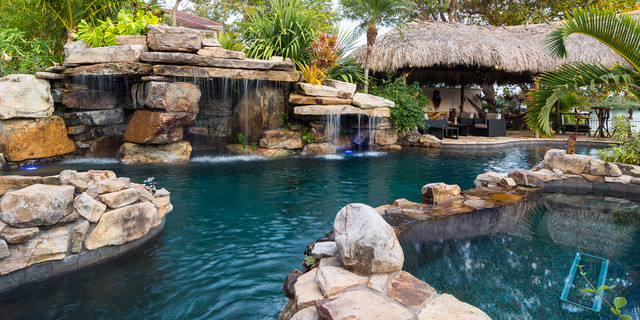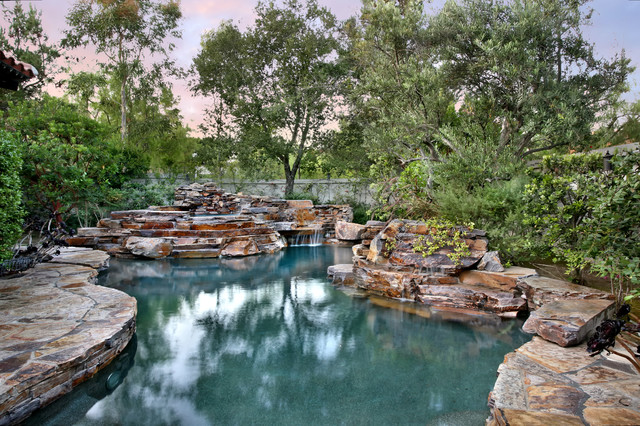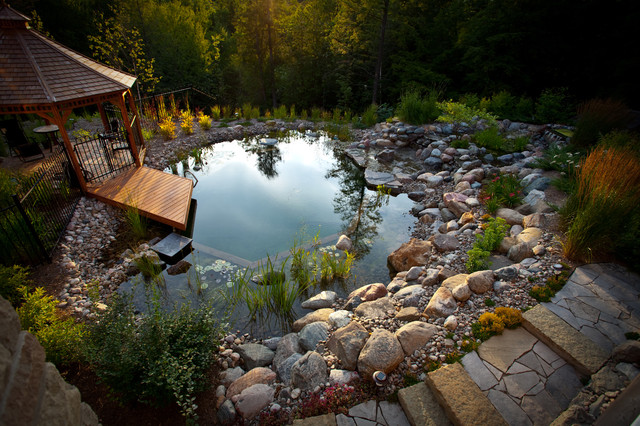Swimming pools are a must-have for plenty of folks, but the chemicals involved? No, thanks. Chlorine doesn’t just dry out your skin and hair—it also leaves that weird chemical smell on towels, clothing, and even skin. So after a summer spent in chlorinated pools, you might be ready to try something a bit more benign, for you and the environment.

Enter: the natural swimming pool. It’s not just the newest summer trend taking the internet by storm, but also a great eco-friendly option for water bums everywhere.
Here’s the lowdown on natural swimming pools with some helpful insights from the experts.
What is a natural swimming pool?

The biggest difference between natural pools and regular ones is the presence of chemicals. While most pools use a whole lab’s worth of chemicals every season to keep them looking fresh, natural pools are much more, well, natural.
“Natural swimming pools are filtered organically,” explains Matt Gresham, director of technical support for America’s Swimming Pool Co. “They don’t need chemicals, and require less pool maintenance, but more gardening.”
So what does “filtered organically” mean? Unlike most regular blue pools, natural swimming pools use plants to clean the water,
But don’t worry—your natural pool won’t be covered in lily pads and tadpoles.
The filtering process for natural pools happens outside of the primary pool, in a secondary pool or “regeneration zone.” As water runs through your aquatic garden in the regeneration zone, plants filter and clean the water.
What’s the maintenance for natural swimming pools?

All pools require maintenance, and natural swimming pools are no exception. But like we mentioned earlier, maintaining natural pools is a bit more like gardening.
“Taking care of the regeneration zone is a must,” Gresham says. “This includes keeping aquatic plants healthy and weeds out, winterizing in the cooler climates, and cleaning skimmer baskets.”
Here’s how it breaks down:
- Empty the leaf skimmer every one to four months.
- In the summer, lightly prune the plants in your regeneration zone.
- In the fall, cut the regeneration zone plants back fully.
- Get the pool fully serviced every three to five years
Much as you would do with a normal pool, you should invest in an electronic surface cleaner to pick up any leaves and debris. This will also give the pool a more polished feel, despite still being natural and chemical-free.
How much does a natural pool cost?

“It’s a myth that natural pools are more expensive,” explains Benjamin Ross, an investor whose family has been in the pool industry for years. “The truth is, they cost about the same to build.”
Ross, who’s also a Realtor®, quotes construction costs for natural pools at roughly $50 to $55 per square foot. The 2019 national average for regular swimming pools is between $50 to $100 per square foot, but can go all the way up to $150 per square foot for larger pools.
Plus, it’s not just building costs you need to factor in. The harsh chemicals used to keep regular pools clean are expensive, and since your natural swimming pool won’t need any of these, you’ll also be saving annually.
How to get your own natural pool
If this has you thinking a natural pool might be the perfect addition to your backyard oasis, first take a look around.
“Plenty of yard space is needed to build a natural swimming pool,” Gresham says.
In fact, he recommends twice the amount of space required for a traditional pool build, to accommodate the regeneration process. While some brave pioneers build their own natural swimming pools, you can, of course, hire companies specializing in them to design and build one for you.
A final tip: A shallow pool will help you save the cost of extra reinforcements for your walls, plus it’ll be cheaper and easier to clean and maintain.
“You’ll save a lot of money by keeping the depth to a maximum of 6 feet,” Ross says.
https://www.realtor.com/advice/home-improvement/natural-swimming-pool-trend/
